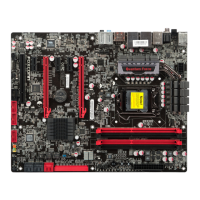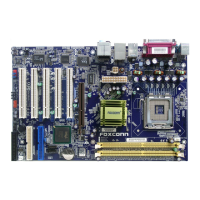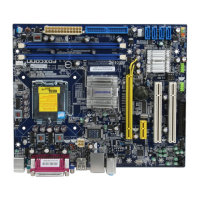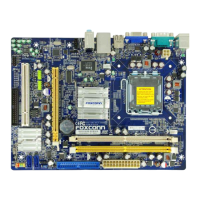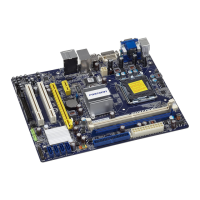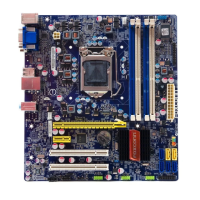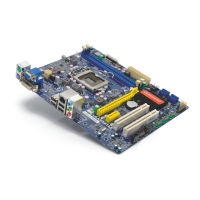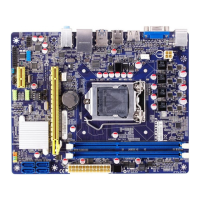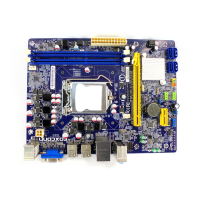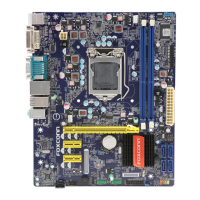Do you have a question about the Foxconn Renaissance and is the answer not in the manual?
Detailed specifications for the motherboard's components, including CPU, memory, and expansion slots.
Visual guide identifying key motherboard components and connectors for easy reference.
Describes all external ports available on the motherboard's rear panel for connectivity.
Step-by-step guide for safely installing the CPU and its associated cooling system.
Instructions on how to correctly insert RAM modules into the motherboard's DIMM sockets.
Guide for installing graphics cards, network cards, or other expansion devices into PCIe slots.
Connecting internal power supply, USB headers, front panel switches, and LEDs.
Explains the functionality of onboard power buttons, reset switches, and diagnostic LEDs.
How to access BIOS and navigate its main menu to configure system settings.
Displays detailed information about the system's hardware, BIOS version, and date.
Configuration options for IDE devices, SuperIO, and other onboard peripherals.
Settings related to the motherboard chipset, including USB and PCIe port configurations.
Control over boot device priority, Quick Boot, and Quiet Boot settings for system startup.
Options for managing system power states and energy saving features via ACPI.
Monitoring system temperatures, fan speeds, and voltages for hardware health.
Proprietary utility for advanced performance tuning, including CPU, memory, and voltage.
Settings for CPU ratio, prefetchers, virtualization technology, and execute disable bit.
Adjusting memory frequency, timings, and voltage for optimal performance.
Setting up supervisor and user passwords to secure access to BIOS settings.
Overview of the included utility CD containing drivers and software to enhance motherboard functionality.
A powerful utility for monitoring and adjusting system performance settings like CPU, voltage, and fans.
Utility for backing up, updating, or restoring system BIOS, drivers, and software utilities.
Utility to manage the boot time logo displayed during the Power-On Self-Test.
Desktop Management Interface viewer for analyzing system hardware information and troubleshooting.
Explains RAID concepts, levels (0, 1, 5, 10), and their benefits for data storage.
Introduction to the software utility for managing RAID arrays and configuring storage volumes.
Step-by-step guide to creating a floppy disk with RAID drivers for OS installation.
Setting SATA mode in BIOS to RAID or AHCI and preparing for RAID volume creation.
Detailed procedures for creating RAID volumes (RAID 0, 1, 5, 10) within the Intel Matrix Storage Manager.
Guide to installing Windows XP on a system with RAID configured, including driver integration.
Adding RAID storage to an existing Windows XP system by installing Intel Matrix Storage Manager.
Procedures for deleting existing RAID volumes and resetting disks back to non-RAID status.
Instructions for setting up ATI's CrossFire technology for enhanced graphics performance with multiple GPUs.
Guide on installing and configuring NVIDIA graphics cards for SLI multi-GPU technology.
Steps to activate SLI features through the NVIDIA Control Panel for multi-GPU setups.
Detailed specifications for the motherboard's components, including CPU, memory, and expansion slots.
Visual guide identifying key motherboard components and connectors for easy reference.
Describes all external ports available on the motherboard's rear panel for connectivity.
Step-by-step guide for safely installing the CPU and its associated cooling system.
Instructions on how to correctly insert RAM modules into the motherboard's DIMM sockets.
Guide for installing graphics cards, network cards, or other expansion devices into PCIe slots.
Connecting internal power supply, USB headers, front panel switches, and LEDs.
Explains the functionality of onboard power buttons, reset switches, and diagnostic LEDs.
How to access BIOS and navigate its main menu to configure system settings.
Displays detailed information about the system's hardware, BIOS version, and date.
Configuration options for IDE devices, SuperIO, and other onboard peripherals.
Settings related to the motherboard chipset, including USB and PCIe port configurations.
Control over boot device priority, Quick Boot, and Quiet Boot settings for system startup.
Options for managing system power states and energy saving features via ACPI.
Monitoring system temperatures, fan speeds, and voltages for hardware health.
Proprietary utility for advanced performance tuning, including CPU, memory, and voltage.
Settings for CPU ratio, prefetchers, virtualization technology, and execute disable bit.
Adjusting memory frequency, timings, and voltage for optimal performance.
Setting up supervisor and user passwords to secure access to BIOS settings.
Overview of the included utility CD containing drivers and software to enhance motherboard functionality.
A powerful utility for monitoring and adjusting system performance settings like CPU, voltage, and fans.
Utility for backing up, updating, or restoring system BIOS, drivers, and software utilities.
Utility to manage the boot time logo displayed during the Power-On Self-Test.
Desktop Management Interface viewer for analyzing system hardware information and troubleshooting.
Explains RAID concepts, levels (0, 1, 5, 10), and their benefits for data storage.
Introduction to the software utility for managing RAID arrays and configuring storage volumes.
Step-by-step guide to creating a floppy disk with RAID drivers for OS installation.
Setting SATA mode in BIOS to RAID or AHCI and preparing for RAID volume creation.
Detailed procedures for creating RAID volumes (RAID 0, 1, 5, 10) within the Intel Matrix Storage Manager.
Guide to installing Windows XP on a system with RAID configured, including driver integration.
Adding RAID storage to an existing Windows XP system by installing Intel Matrix Storage Manager.
Procedures for deleting existing RAID volumes and resetting disks back to non-RAID status.
Instructions for setting up ATI's CrossFire technology for enhanced graphics performance with multiple GPUs.
Guide on installing and configuring NVIDIA graphics cards for SLI multi-GPU technology.
Steps to activate SLI features through the NVIDIA Control Panel for multi-GPU setups.
| Model | Renaissance |
|---|---|
| Manufacturer | Foxconn |
| Form Factor | ATX |
| Memory Slots | 4 |
| PCIe x16 Slots | 2 |
| PCIe x1 Slots | 2 |
| IDE Ports | 1 |
| Ethernet | Gigabit Ethernet |
| LAN | Gigabit |
